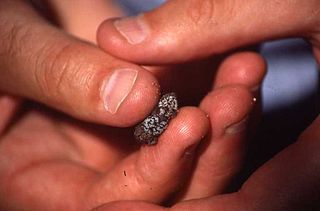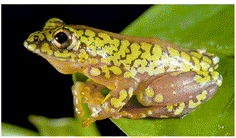
The Kihansi spray toad is a small toad endemic to Tanzania. The species is live-bearing and insectivorous. The Kihansi spray toad is currently categorized as "Extinct in the wild" by the International Union for Conservation of Nature (IUCN), though the species persists in ex situ, captive breeding populations.
Nectophrynoides wendyae, also known as the Uzungwe Scarp tree toad or Wendy's forest toad, is a terrestrial toad in the family Bufonidae. It is endemic to Tanzania and is only known from a single valley in the Udzungwa Mountains. The specific name wendyae honours Wendy Clarke, the describer's wife.

Atelopus certus, the Darien stubfoot toad or Toad Mountain harlequin frog, is a species of toad in the family Bufonidae endemic to Panama.

Rhinella achalensis is a species of toad in the family Bufonidae that is endemic to northern Argentina.
The Inyanga toad or Inyangani toad is a species of toad in the family Bufonidae. It is known from the Inyanga Mountains of eastern Zimbabwe at elevations of 2,400–2,560 m (7,870–8,400 ft) asl; it is expected to occur in the adjacent Mozambique but has not been recorded there, probably because of lack of surveys. Originally described as a subspecies of Bufo gariepensis, most recent treatments have treated it as a full species.
Mertensophryne lindneri is a species of toad in the family Bufonidae. It is found on the coastal lowlands of eastern Tanzania and northern Mozambique to southeastern Malawi, up to 650 m (2,130 ft) asl. Its habitats are woodlands, thickets, dry forests, farmland, and even rocky outcrops; it tolerates low-intensity cultivation. Its breeding habitat is unknown but presumably includes ponds or streams. It is considered uncommon but also difficult to observe, typically found after heavy rain. The intensification of agriculture and expanding human settlements are considered likely threats to it.
Mertensophryne lonnbergi is a species of toad in the family Bufonidae. It is endemic to Kenya and known from the highlands on both sides of the Great Rift Valley as well as from Mount Kenya. Its natural habitats are montane grasslands, moorlands, and forest patches; it can survive also on agricultural land. Breeding takes place in small and shallow permanent or semi-permanent pools. It is a reasonably common species, but habitat modification could still be a threat.
Mertensophryne melanopleura is a species of toad in the family Bufonidae. It is known from its type locality, the Upemba National Park in southern Democratic Republic of the Congo, and from eastern Angola and south of Ndola in northern Zambia.
Mertensophryne mocquardi is a species of toad in the family Bufonidae. It is endemic to Kenya and known from Mount Kenya, the Kinangop Plateau, and the highlands surrounding Nairobi. The specific name mocquardi refers to François Mocquard, a French herpetologist. It was put in synonymy of Mertensophryne lonnbergi in 1972, but re-validated in 1997.
Mertensophryne nyikae is a species of toad in the family Bufonidae. It is endemic to the Nyika Plateau of northern Malawi and adjacent northeastern Zambia. Its natural habitats are montane forests and nearby wet, boggy grasslands at approximately 2,500 m (8,200 ft) asl. Breeding takes place in small, shallow pools. Although its range is mostly within relatively well managed protected areas, habitat loss remains a potential threat.
Mertensophryne schmidti is a species of toad in the family Bufonidae. It is endemic to Democratic Republic of the Congo and only known from the Upemba National Park.
Mertensophryne taitana is a species of toad in the family Bufonidae. It is found in southeastern Kenya and southward through Tanzania to southeastern Democratic Republic of the Congo, northern Zambia, Malawi, and adjacent Mozambique. Its natural habitats are sandy places in woodlands, grasslands, open savanna, and agricultural fields. It is an opportunistic breeder utilizing small, temporary pools, and apparently, streams. The tadpole develop very fast, reaching metamorphosis in only 13 days. This adaptable species is not believed to face any significant threats.

Mertensophryne micranotis is a species of toad in the family Bufonidae. It is found in southeastern Kenya and eastern Tanzania, including Zanzibar and Songo Songo Island. Its natural habitats are lowland forests, dense woodlands, thickets, and the forest-miombo woodland boundaries. It is regularly seen but difficult to detect. It is probably affected by habitat loss caused by agriculture, wood extraction and human settlement.
Nectophrynoides viviparus is a species of toad in the family Bufonidae. It is endemic to Tanzania. Common names robust forest toad and Morogoro tree toad have been coined for it.
The Chirinda toad, Chrinda forest toad, Mashonaland toad or Boulenger's earless toad is a species of toad in the family Bufonidae with a restricted distribution in eastern Zimbabwe and western Mozambique.
Mertensophryne howelli is a species of toad in the family Bufonidae. It is endemic to the coast of Tanzania and known from the Mafia Island and Zanzibar. The species is named after professor Jim Howell for his contributions to the herpetology of Tanzania.
The Mahenge toad or Loveridge's forest toad, Mertensophryne loveridgei, is a species of toad in the family Bufonidae. It is endemic to Tanzania; its common name refers to the Mahenge Plateau where it can be found. Its natural habitats are tropical forests and woodlands. It is not considered threatened by the IUCN.
Mertensophryne usambarae is a critically endangered species of toad in the family Bufonidae. It is endemic to the foothills of the East Usambara Mountains, northeastern Tanzania.
Afrixalus uluguruensis is a species of frog in the family Hyperoliidae. Its common name is Uluguru banana frog. It is endemic to the Eastern Arc Mountains of Tanzania and known from the Kipengere Range, Mahenge, Udzungwa Scarp, Rubeho, North Uluguru, Nguru, Ukaguru, and Nguu Mountains.

Hyperolius minutissimus is a species of frog in the family Hyperoliidae. Its common names are tiny reed frog and dwarf reed frog. It is endemic to Tanzania and known from the Udzungwa Mountains and from near Njombe in the Southern Highlands.





